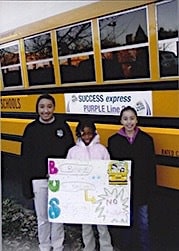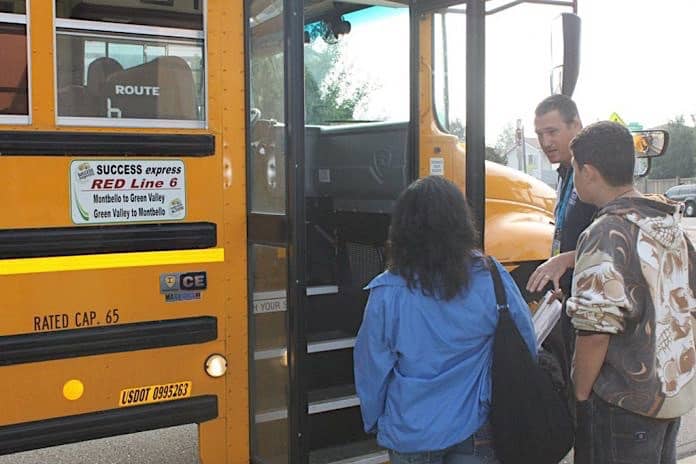Since Nicole Portee came on board as executive director of transportation of Denver Public Schools (DPS) in 2010, she has helped launch an innovative shuttle service, mainstreamed students with special needs on buses and increased ridership, with her department picking up an award along the way.
The Success Express bus shuttle system operates much like fixed-route city buses, offering students three opportunities to catch a ride. Now in its second year, the shuttle runs from 6:30 to 9:30 a.m., and then from 2:30 to 6:30 p.m., ensuring more flexible school days and on-time access for students to their participating school of choice.
School Transportation News had the opportunity to speak with Portee about the shuttle service and other transportation issues facing her large metropolitan school district.
STN: So how is it going with the Success Express shuttle service?

Portee: The Success Express is totally different than regular school bus service, and we have districts in other parts of town that want to roll it out. We’re looking at expanding and getting bigger and better, but not this year. Now, we’re looking at how we define success in terms of the shuttle service. In the Northeast areas, we’re averaging about 1,500 students in the morning and 1,800 in afternoon, from ECE (early childhood education) through 12th grade. We have approximately 400 buses district-wide and transport about 22,000 students — 25 percent out of about 83,000.
Looking at the arterial layout of community, we’re doing a lot of in-depth analysis of the shuttle service and asking ourselves: Is this the right move for this area? I don’t think the shuttle service is one-size-fits-all.
STN: Does the shuttle service encourage more ridership?
Portee: Most definitely. DPS is looking at each of its regions and at different transportation models, duplicating those that are successful and trying to reduce the number of buses traveling all the way across town. This allows kids to stay in their community … but service still exists for those kids who do choose a school across town — it’s just not as frequent. Everyone is eligible to ride the shuttle. Some parents were skeptical about the shuttle service at first. It was a shift in how we provide transportation. It also gave us the opportunity to educate the community about the latest technology on buses. We have cameras, and we have a bus assistant on every bus.
The flip side is that we’ve learned about kids’ behavior. We know they enjoy meeting up with friends at the bus stop and hanging out until the last bus gets there. Now, we’ve built a schedule that forces kids to get on the bus and get to school. So instead of a late bus, we have several buses come at once so the students have to get on at the same time. We’ve had to adapt.
STN: What are your top priorities when preparing for a new school year?
Portee: Our focus this year is really about training our employees. We are doing a mixture of instructional as well as hands-on training. In previous years, we’ve had one or two days to provide employees with in-service training. This year we extended it to a whole week. We had hands-on stations set up for employees: drivers and paraprofessionals as well as fleet and management workers. Stations featured BESI seats, wheelchair tie-downs and different scenarios like evacuation, providing the opportunity for hands-on training and one-on-one conversation.
For the classroom instruction, we’ve invited several internal departments like student services (special education) to hit on areas such as de-escalation techniques … Looking at the headlines about bullying and parents coming on buses, we feel like we need to step up training for employees and give them the right tools. We’re here to ensure students are transported safely.
STN: What challenges are you addressing as the new school year commences?
Portee: All of our busing is integrated, so we have special ed students with regular ed. We’ve seen peaks and lows in homeless students that need additional transportation, and right now it has leveled off. We’re actually having a conversation among districts in terms of how we can share costs when transporting our homeless students. We have a very good homeless liaison who seeks out if we can provide transportation to the student before making an assessment. It’s a process.
 In our district, we have a school of choice office. Denver is moving into a choice district, where you have the ability to choice into schools that fit your student’s needs. Our planning department is also involved to ensure there are enough seats made available. That information then comes to transportation. We’re the last to get this information before we can start working on routes. We’re now going to start servicing charter schools and also innovative schools. New schools are coming on each year, forcing us to think differently about how we can provide transportation. How can we create a more innovative model that would otherwise support choice in the district as well as get students on buses?
In our district, we have a school of choice office. Denver is moving into a choice district, where you have the ability to choice into schools that fit your student’s needs. Our planning department is also involved to ensure there are enough seats made available. That information then comes to transportation. We’re the last to get this information before we can start working on routes. We’re now going to start servicing charter schools and also innovative schools. New schools are coming on each year, forcing us to think differently about how we can provide transportation. How can we create a more innovative model that would otherwise support choice in the district as well as get students on buses?
STN: Have you made any fleet upgrades recently?
Portee: We have GPS and the latest technology on buses to give parents a sense of peace and confidence about our ability to transport their students. We just finished working with Zonar and are looking at whether to move forward with the ZPass, which would enhance our shuttle system. Our focus is about giving parents and schools accessibility to track students because we have so many getting on and off the buses.
This next school year we will purchase new (wheelchair) lift buses. Our fleet is about 7.6 years old. We have probably one of the newest fleets in the state of Colorado.
STN: What else is in the works?
Portee: A lot of districts nationwide have chartered out transportation, but for us, it’s a little personal. A large number of our bus drivers and paraprofessionals are parents of children who attend our schools. We want to keep them working. We also want them to feel they are contributing to the bigger picture by tying in transportation to the school structure. We’re really pushing that we are part of the instructional day.
In the next few months, we are rolling out our new brand. Instead of being DPS Transportation, we will have a brand so we can personalize what we do: Yes, we do drive yellow buses but that’s not who we are. Now we’re going through a branding campaign to paint a picture of the services we provide and how we are cost-effective. We have been working with a marketing firm since March and plan to introduce it in September.
I really treat this like a business. I can’t take for granted that these schools will always exist, so I need to think about why schools — and parents — would choose DPS Transportation. Schools need to be able to communicate the statistical information about DPS and why school buses are the safest mode of transportation.
STN: Thank you!
Read more about Denver Public Schools and its back-to-school operations in the September 2012 edition of School Transportation News magazine.
















